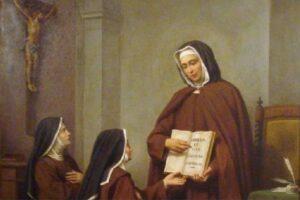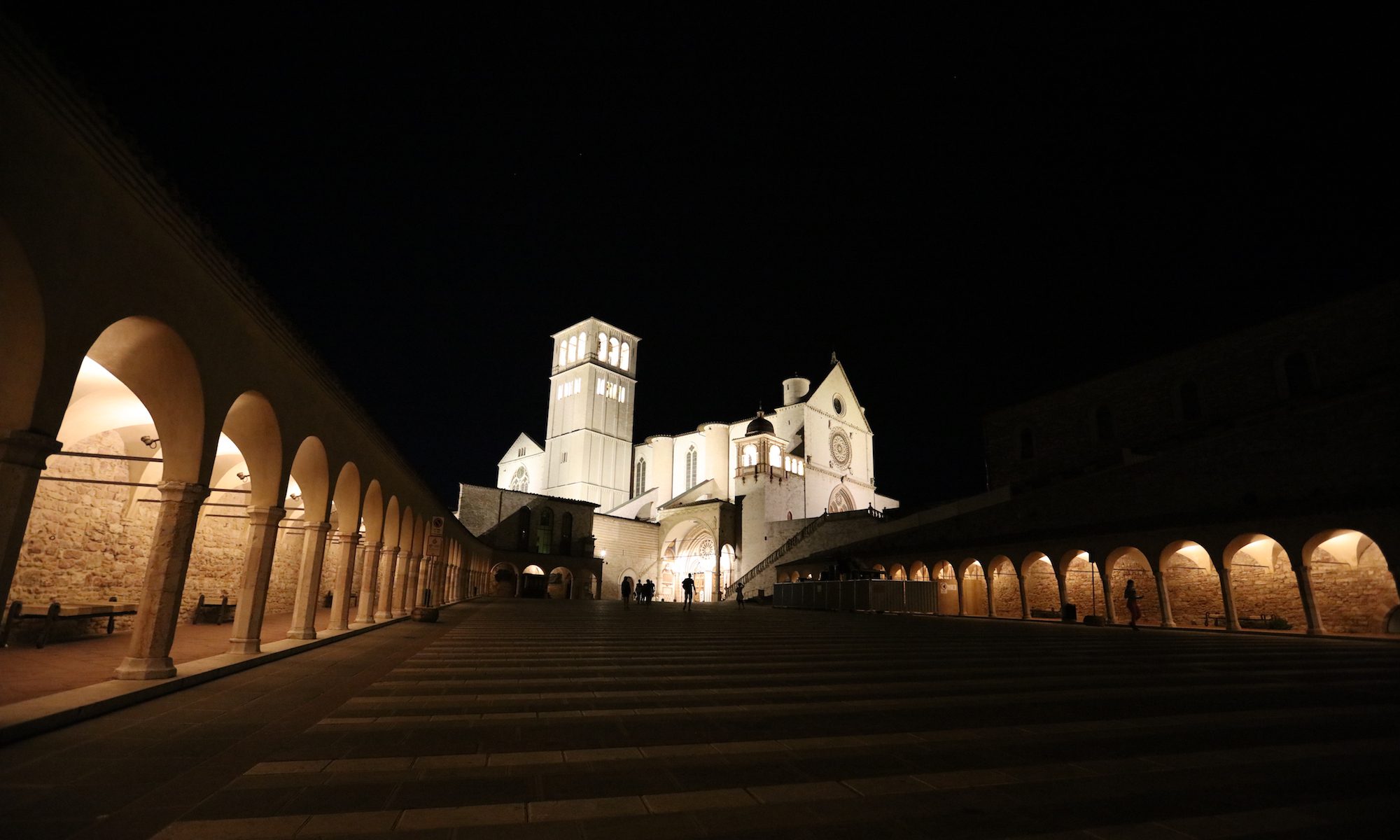Foundress of Capuchin Poor Clares (c. 1463-1539)
Maria Lorenza was born in Lérida (Spain) in 1463. Married to Joan Lonc, jurist in the chancellery of Ferdinand the Catholic, she moved with him to Naples in 1506. Paralysed after a poisoning, she was cured in Loreto in 1510. As a widow, she dedicated herself to the sick and in 1519, together with Ettore Vernazza, with funds from her property she founded the hospital of Santa Maria del Popolo, known as the Incurabili. It was for syphilis patients and women in distress. In 1535, on the advice of St. Gaetano Thiene, she founded the monastery of Santa Maria in Gerusalemme, adopting the first rule of St. Clare and the constitutions of St. Coletta, receiving papal approval and the spiritual care of the Capuchins in 1538. She died at the age of 76, in October 1539. She was beatified in Naples on 9 October 2021.
 The place and year of the birth of Maria Lorenza Longo are not precisely known. She was certainly of Catalan origin, probably born in Lleida around 1463 from the noble Riquençà or Requesens family. At a very young age, she married Juan Llong, regent of the Council of Aragon. One day during a party she was poisoned by her maid, who harbored resentment towards her. As a result, she suffered paralysis in her lower limbs. Yet in 1506, despite her debilitation, she followed her husband to Naples.
The place and year of the birth of Maria Lorenza Longo are not precisely known. She was certainly of Catalan origin, probably born in Lleida around 1463 from the noble Riquençà or Requesens family. At a very young age, she married Juan Llong, regent of the Council of Aragon. One day during a party she was poisoned by her maid, who harbored resentment towards her. As a result, she suffered paralysis in her lower limbs. Yet in 1506, despite her debilitation, she followed her husband to Naples.
In 1509, after the death of her husband, Maria Lorenza was led on a pilgrimage to the Shrine of Loreto, where she obtained the grace of a sudden recovery. After returning to Naples and arranging for the accommodation of her children, she devoted herself entirely to the exercise of charity at the hospital of San Nicola al Molo. In 1519, encouraged by Ettore Vernazza, she pursued the foundation of a hospital for incurables, which was opened on March 23, 1522.
The so-called “incurable” patients were mainly victims of the “French Disease”, i.e. Syphilis. Her zeal also led her to take care of street women, for whom she founded Il Monastero delle Pentite.
In 1530 the first Capuchins arrived in Naples and were welcomed by Maria Lorenza Longo in the outbuildings of the hospital. Three years later she practiced the same kind of hospitable charity with the Theatines.
Some women had joined her, and soon it was decided to bring to bear a new cloistered institution. On February 19, 1535, Paul III authorized her to build a monastery under the Rule of St. Clare near the hospital for incurables. A new reformed branch of sisters of the Franciscan Second Order was born, which, following the example of the Capuchins, took the same path of a poor and austere life and adopted the same name. In July 1535, the first religious entered the new monastery of Santa Maria in Gerusalemme.
On April 30, 1536, with a new papal brief, Maria Lorenza obtained the right to increase the number of sisters to thirty-three, which prompted the monastery from that day on to be known as the “Monastery of the Thirty-three”. On December 10, 1538, Paul III granted – quite exceptionally – that they benefit from the spiritual care and direction of the Capuchins.
While the year of her birth is completely uncertain, the time of her death, based on evidence from various documents, was surely to have been sometime during the second half of 1539.
Beatified in Naples, Italy on October 9, 2021.
For further reading see the Letter of the Capuchin Minister General Roberto Genuin 17 September 2021.
A reading from the “Life” of Mattia da Salò
Historia Capuccina, vol. II, Monumenta historica Ordinis Minorum Capuccinorum, 6, Romae 1950, 266-272, nos. 320-321,324,326
Not great works, but a tiny bit of faith saved me
When she closed herself away in the monastery, Mother Maria Lorenza gave herself over to prayer and meditation, since due to infirmity she could not do any manual labour due to infirmity, and taught her daughters to observe the Rule according to the intention of St Francis and St Clare. In this she was guided by the council of the Capuchin friars, who confessed and spiritually cared for all the nuns. Above all, she was zealous for divine worship and trained and encouraged the nuns in it. Since the choir had not yet been built, she had the divine office celebrated in a small room, where, having been brought there, she attended with the others. She received Holy Communion every eight days and on all the feasts as required, and on those day she lived in recollection, shedding many tears during prayer and remaining in contemplation, as if going out of herself. Don Gaetano da Thiene, one of the first founders of the institute of the Theatine Fathers, often visited her, because she profoundly reflected upon the divine mysteries and gave admirable and profound interpretations of the Divine Scriptures, before which he was amazed and full of consolation. He said that from her he had received great light: more than from reading books. So it was with all the others, who came to see her for this reason. And those who were troubled received great consolation from her presence and from her reflections. Noble lords sought to recommend themselves to her prayers, to listen to her advice and reasoning, in which she often revealed hidden things to them. For this reason, she was held in great esteem and was regarded as a divine oracle.
But above all she formed her nuns, making sure that, in what little time she had left to live, she could instruct them well, proceeding in all things, both material and spiritual, with great spirit and prudence. She admonished and corrected them with wonderful fervour, both in general matters and in particular ones. And many times, she would discern the temptations of the sisters, revealing to them the inner disposition of the heart; and because of this they, confounded and amazed, would correct themselves.
After renouncing the office of abbess, she did nothing else but speak of the observance of God’s precepts and the Rule, of peace and union, of humility, obedience and poverty, of mortification and self-abasement, exhorting the sisters, very effectively, to master themselves. She did this with such fervour, intensity and kindness that she moved them all to tears and inflamed them in the love of God.
Shortly before she passed away, she turned to her sisters and said to them: ‘Sisters, it seems to you that I have done great things of good works; but I trust in nothing of myself, but all in the Lord’, and showing the tip of her small finger, she said: ‘A tiny bit of faith saved me”. Her blessed body was placed before the grille; and a multitude of people came, and all kissed her feet and cried out that her feet emitted the odour of perfume. Since Mother Maria Lorenza had left word that she wished to be buried with her sisters, but there was no cemetery yet, they placed her in a coffin and placed it under the high altar of the choir.
Prayer
Almighty and eternal God,
who in blessed Maria Lorenza
gave the Church a shining example
of contemplation and loving kindness
grant that we too may follow Christ, poor and crucified,
to come with her into the glory of your kingdom.
Through our Lord Jesus Christ your Son,
who lives and reigns with you,
in the unity of the Holy Spirit,
God, for ever and ever. Amen
